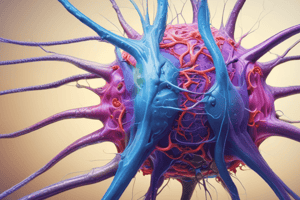Podcast
Questions and Answers
A 58-year-old patient suffered a left middle cerebral artery stroke affecting the primary motor cortex
controlling right hand movement. Six months later, MRI studies show increased activity in the supplementary motor area during right hand movement tasks, despite this area not being previously involved in fine motor control of the
hand. This phenomenon BEST represents:
A 58-year-old patient suffered a left middle cerebral artery stroke affecting the primary motor cortex controlling right hand movement. Six months later, MRI studies show increased activity in the supplementary motor area during right hand movement tasks, despite this area not being previously involved in fine motor control of the hand. This phenomenon BEST represents:
- Neuronal Recovery
- Neuronal Compensation (correct)
- Functional Recovery
- Functional Compensation
A 45-year-old man presented to the ophthalmology clinic with complaints of progressive vision loss over the past six months. He reported difficulty seeing objects on the outer sides of his visual field, often bumping into things while walking. On examination, his visual acuity was normal, but a visual field test revealed a loss of vision in the temporal halves of both eyes. The patient was diagnosed with a pituitary adenoma, a common cause of this type of visual field defect
A 45-year-old man presented to the ophthalmology clinic with complaints of progressive vision loss over the past six months. He reported difficulty seeing objects on the outer sides of his visual field, often bumping into things while walking. On examination, his visual acuity was normal, but a visual field test revealed a loss of vision in the temporal halves of both eyes. The patient was diagnosed with a pituitary adenoma, a common cause of this type of visual field defect
- Bitemporal Hemianopsia (correct)
- Homonymous Hemianopsia
- Diabetic Retinopathy
- Glaucoma
A 47-year-old patient presents with diplopia and ptosis of the right eyelid. The pupil is dilated and nonreactive to light. All other eye movements and visual functions. Which cranial nerve is most likely affected?
A 47-year-old patient presents with diplopia and ptosis of the right eyelid. The pupil is dilated and nonreactive to light. All other eye movements and visual functions. Which cranial nerve is most likely affected?
- CN II (Optic Nerve)
- CN III (Oculomotor Nerve) (correct)
- CN IV(Trochlear Nerve)
- CN VI (Abducens Nerve)
Visual agnosia, the inability to recognize objects despite intact basic visual abilities, is most commonly associated with damage to:
Visual agnosia, the inability to recognize objects despite intact basic visual abilities, is most commonly associated with damage to:
Which type of photoreceptor is most abundant in the peripheral retina and functions in low light conditions?
Which type of photoreceptor is most abundant in the peripheral retina and functions in low light conditions?
Most retinal ganglion cell axons that form the optic nerve will go on to project to which structure in the diencephalon?
Most retinal ganglion cell axons that form the optic nerve will go on to project to which structure in the diencephalon?
The optic chiasm is where:
The optic chiasm is where:
A 67-year-old patient presents to the emergency room with severe dizziness and spinning when lying flat however only lasts for
a few seconds. CT and MRI scan demonstrated no evidence of hemorrhage or structural abnormalities. NIHSS was 0. What is the most likely cause of the dizziness based on the information?
A 67-year-old patient presents to the emergency room with severe dizziness and spinning when lying flat however only lasts for a few seconds. CT and MRI scan demonstrated no evidence of hemorrhage or structural abnormalities. NIHSS was 0. What is the most likely cause of the dizziness based on the information?
A 65-year-old patient presents with hearing loss in the right ear. During examination, the Weber test shows lateralization to the right ear. Which type of hearing loss does this patient most likely have?
A 65-year-old patient presents with hearing loss in the right ear. During examination, the Weber test shows lateralization to the right ear. Which type of hearing loss does this patient most likely have?
Which of the following statements is true regarding nystagmus?
Which of the following statements is true regarding nystagmus?
Which statement about the vestibulo-ocular reflex (VOR) and gaze stability is FALSE
Which statement about the vestibulo-ocular reflex (VOR) and gaze stability is FALSE
Which of the following is LEAST likely to be a direct function of the vestibular system?
Which of the following is LEAST likely to be a direct function of the vestibular system?
Which of the following semicircular canals is oriented perpendicular to the others?
Which of the following semicircular canals is oriented perpendicular to the others?
When the head rotates in the plane of a specific semicircular canal, what happens?
When the head rotates in the plane of a specific semicircular canal, what happens?
Based on the pictured head CT scan, what impairment is this patient likely to demonstrate?
Based on the pictured head CT scan, what impairment is this patient likely to demonstrate?
Flashcards
Capital of France (example flashcard)
Capital of France (example flashcard)
Paris



